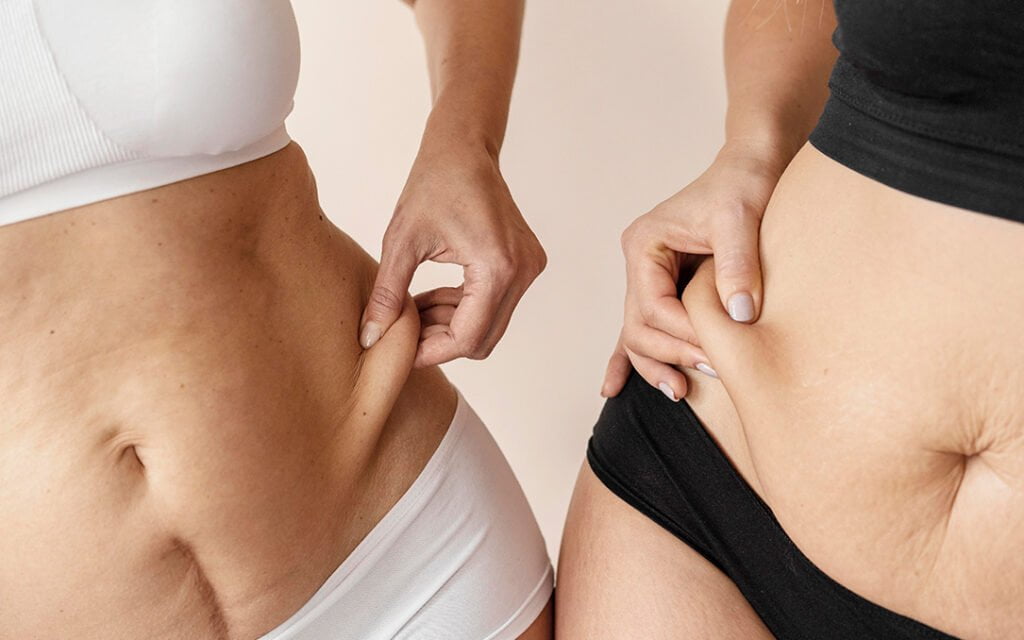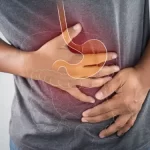Managing Stretch Marks on the Stomach
Stretch marks on the stomach or any other part of the body, medically known as striae distensae, are a common skin condition that affects individuals of all ages and genders.
While they pose no health risks, they can significantly impact one’s self-esteem and confidence, especially when they occur on visible areas like the stomach.
In this article, we delve into the causes, prevention strategies, and treatment options for stretch marks on the stomach, empowering you with knowledge to better manage this common concern.
Understanding Stretch Marks on the Stomach
Stretch marks are characterized by parallel lines or streaks on the skin, ranging from pink to purple initially and eventually fading to a lighter color.
They often appear on areas of the body where the skin is subjected to rapid stretching, such as the abdomen, thighs, hips, breasts, and upper arms.
On the stomach, stretch marks commonly occur during periods of rapid weight gain or loss, pregnancy, puberty, and hormonal changes.
SEE ALSO: Ten Worst Foods for Prostate Health
Causes of Stretch Marks on the Stomach
- Pregnancy: One of the primary causes of stretch marks on the stomach is pregnancy. As the baby grows, the skin stretches to accommodate the expanding uterus, leading to the formation of stretch marks.
- Rapid Weight Gain or Loss: Sudden fluctuations in weight can put undue stress on the skin, causing it to stretch beyond its elastic limit and resulting in the formation of stretch marks.
- Puberty: Adolescents may experience rapid growth spurts during puberty, leading to the stretching of the skin and the development of stretch marks on various parts of the body, including the stomach.
- Hormonal Changes: Hormonal imbalances, such as those occurring during puberty, pregnancy, or hormonal therapy, can weaken the skin’s elasticity, making it more prone to stretch marks.
Prevention Strategies for Stretch Marks on the Stomach
While it may not be possible to entirely prevent stretch marks, especially during pregnancy or puberty, there are several strategies that may help minimize their appearance:
- Hydration: Keeping the skin well-hydrated can improve its elasticity and resilience. Drink plenty of water and use moisturizers or oils specifically formulated to nourish the skin.
- Gradual Weight Management: Aim for gradual and steady weight loss or gain, rather than rapid fluctuations, to minimize the risk of stretch marks.
- Balanced Diet: Consuming a nutrient-rich diet that includes vitamins A, C, D, and E, as well as zinc and protein, can support skin health and elasticity.
- Regular Exercise: Engage in regular physical activity to maintain muscle tone and promote healthy circulation, which can benefit the skin’s overall appearance.
- Use of Topical Treatments: Applying creams, lotions, or oils containing ingredients such as retinoids, hyaluronic acid, or collagen may help improve skin elasticity and reduce the severity of stretch marks.
Treatment Options for Stretch Marks on the Stomach
While stretch marks may fade over time, they often do not completely disappear on their own. However, several treatment options can help minimize their appearance:
- Topical Treatments: Over-the-counter creams, lotions, and oils containing ingredients such as retinoids, hyaluronic acid, vitamin C, or collagen may help improve the appearance of stretch marks by promoting collagen production and skin regeneration.
- Prescription Medications: In some cases, dermatologists may prescribe topical retinoid creams or oral medications to help fade stretch marks and improve skin texture.
- Laser Therapy: Laser treatments, such as fractional laser therapy or pulsed dye laser therapy, can stimulate collagen production, reduce redness, and improve the texture of stretch marks.
- Microdermabrasion: This minimally invasive procedure involves exfoliating the outer layer of the skin to promote cell turnover and improve the appearance of stretch marks.
- Microneedling: Also known as collagen induction therapy, microneedling involves creating tiny punctures in the skin to stimulate collagen production and enhance skin texture.
Stretch marks on the stomach are a common cosmetic concern that can affect individuals of all ages and genders. While they may not pose any health risks, they can impact one’s self-confidence and body image.
By understanding the causes of stretch marks, implementing prevention strategies, and exploring treatment options, individuals can take proactive steps to manage and minimize the appearance of stretch marks on their stomach.
Remember, embracing your body’s changes and imperfections is a vital part of self-love and acceptance.
YOU MAY LIKE: Ketogenic Diet for Schizophrenia
How To Get Rid of Stretch Marks on the Stomach
Stretch marks on the stomach are like scars that show up when your skin stretches quickly. They aren’t dangerous, but some people don’t like how they look. There isn’t a magic way to get rid of them completely.
Here’s what you can do:
- Wait it out: Stretch marks often fade on their own over time.
- Moisturizer: While it probably won’t erase stretch marks, you can try gently massaging moisturizer into them for a few weeks.
- Self-tanner: This can temporarily hide the difference in color between your skin tone and the stretch marks.
- Prescription creams: A doctor might prescribe creams like hyaluronic acid or tretinoin to help improve the appearance of early stretch marks.
If you want to see results faster, you can visit a dermatologist. They can offer treatments like lasers or microdermabrasion to make stretch marks less noticeable. Keep in mind that these procedures may cause some side effects and aren’t guaranteed to work completely.
Summary
Stretch marks on the stomach are a very common occurrence, affecting up to 90% of pregnant women. They are essentially a type of scar that develops when the skin rapidly stretches or shrinks. This can happen during pregnancy, puberty, rapid weight gain or loss, and even bodybuilding.
While stretch marks on the stomach or on any other part of the body are completely harmless, some people find them unsightly. The good news is that they often fade over time, and there are even some treatments that can help improve their appearance.
Here are some useful insights on stretch marks on the stomach:
- Causes: As mentioned earlier, the main cause of stretch marks is rapid skin stretching. This can be caused by pregnancy, puberty, rapid weight gain or loss, and bodybuilding. Genetics also play a role, so if your parents have stretch marks, you’re more likely to get them too.
- Appearance: Stretch marks typically appear as red, pink, or purple indented streaks on the skin. They may feel slightly raised or rough at first, but over time they will flatten and fade to a silvery white color.
- Prevention: While there is no guaranteed way to prevent stretch marks, there are a few things you can do to minimize your risk. These include keeping your skin well-hydrated by drinking plenty of water and using a good moisturizer, eating a healthy diet to support skin health, and maintaining a healthy weight.
- Treatment: There is no cure for stretch marks, but there are some treatments that can help improve their appearance. These include topical retinoids, laser therapy, and microneedling. However, it is important to note that these treatments are not always effective, and they can be expensive.
If you are concerned about stretch marks on your stomach, talk to your doctor. They can help you decide if treatment is right for you.
Here are some additional tips for dealing with stretch marks:
- Maintain a healthy weight: This will help to reduce the amount of stress on your skin.
- Eat a healthy diet: Eating a diet that is rich in nutrients will help to keep your skin healthy.
- Stay hydrated: Drinking plenty of water will help to keep your skin plump and elastic.
- Use a moisturizer: A good moisturizer will help to keep your skin hydrated and supple.
- Avoid harsh soaps and scrubbing: This can irritate your skin and make stretch marks more noticeable.
- Wear sunscreen: Sun exposure can damage your skin and make stretch marks more noticeable.
By following these tips, you can help to improve the appearance of stretch marks on your stomach and boost your overall skin health. Remember, stretch marks are a normal part of life, and they don’t affect your health in any way.

A graduate of Computer Science and Information Management Technology. Diploma – Caregiving, Certificates – Dementia and Diabetes Awareness and Management. A researcher, blogger, songwriter, singer and acoustic guitarist. Born in an environment where natural talents such as healing are imparted at our natural birth. This natural talents of healing is the result of our genetic inheritance and the training from family environment.












